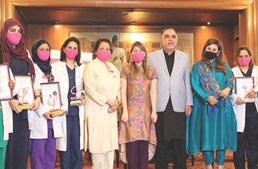A harsh winter could claim the lives of thousands more people in flood-stricken parts of Pakistan.
Thousands of individuals who have been displaced and are still living in tents are suffering from ailments related to the cold.
DERA MURAD JAMALI:
Mohammad Jamal’s main protection against the biting cold is a thin sweater, an acrylic shawl with patches, and a pair of plastic shoes. This stinging cold has significantly added to a bombardment of difficulties that he and his family have been suffering for almost two months.
The family is currently living in a tarpaulin tent along the main highway in Dera Murad Jamali, a remote district located in the southwestern region of Balochistan province. This region was one of the regions that was hit the hardest by the recent rains and super floods. Despite their best efforts, the family is having trouble surviving the harsh winter, which seems to be another one of their nightmares.
It has been almost four months since massive rains along with near-apocalyptic floods struck Pakistan, inundating a third of the South Asian country, and thousands of victims are still lodged in tents, shelter camps, or along highways throughout the southern Sindh and Balochistan provinces. These provinces are located in the south of Pakistan.
The struggle that they are going through is one that is shared by dozens of other families seeking safety in the regions.
The fact that both sides of the highway are still submerged in stinking floodwater makes the effects of the chilly weather even worse.
Many of the children in the group were moving around barefoot, while others were wearing slippers or plastic shoes. The adults were keeping warm by sitting around a fire in the middle of the gathering.
However, collecting dry wood for fires is another chore that needs to be completed by the affected individuals. In order to obtain some, they have to trek along the roadway, as the majority of the region surrounding their temporary housing complex is still flooded.
As a result of the inadequate protection provided by the flimsy tent sheets against the biting cold, almost everyone present at the facility was suffering from some form of illness, such as coughing, sneezing, or other respiratory symptoms.
“It seems like almost everyone in this place is sick. This is something that I can say with absolute certainty,” said Jamal, who had been employed as a labourer on farms in the outskirts of Dera Murad Jamali prior to the heavy rains and floods that occurred at the beginning of September.
The floodwaters have not receded from the countryside, and his home, like with hundreds of thousands of others, has been levelled, making it impossible for him to return.
According to Jamal, a father of four who spoke with Anadolu Agency, the winter has introduced a new set of diseases to those who were affected by the flood.
“We were already battling a number of waterborne, eye, and skin-related ailments, and now we’re dealing with dengue, pneumonia, cough, flu, and other illnesses,” he continued by saying.
There are some trying months ahead.
In the event that the patient becomes ill, his family will either take him on a bull or donkey cart to the local hospital, which is located five kilometres (three miles) away, or they will look for a lift.
According to Jamal, “many people, including children and women, pass away from pneumonia, gastroenteritis, and other ailments, but none of this is publicised.”
Since the middle of June, the rains and floods have been responsible for nearly 1,700 casualties, according to the government’s latest estimates.
Despite this, relief organisations and health professionals believe the numbers are far higher than the official records indicate. This is due to the fact that deaths caused by post-flood conditions, most notably illnesses, are not accounted for in the statistics.
The Pakistan Medical Association (PMA), a national organisation comprised of medical experts, is also of the opinion that the number of flood-related fatalities is “manifold” larger than the figures that have been reported by the government.
Another person who was affected by the flood, Dilbar Hussein Mangi, believes that the following months would be much more difficult.
“Traditionally, December and January are the coldest months, with intermittent showers,” Mangi, a farmer and father of five, told Anadolu Agency. “It’s been that way for a long time.”
He was afraid that if it started to rain, the tents where they were taking cover would become useless.
These tents are incapable of preventing the nighttime flow of (cold) air. How could they possibly keep the rain away from us? ” he made his case.
Health experts sound the alarm
Salman Ali, an official with the Al-Khidmat Foundation, which is one of the largest relief organisations in the country, estimates that the number of flood-affected people who are still living in tents is in the thousands, despite the fact that there are no official figures to specifically count the number of people who are still living in tents.
“The vast majority of those who were forced to flee their homes have since returned. “Many of them are living in tents (on their land) provided by the government or aid groups during the time of their displacement,” Ali told Anadolu Agency. This is because their homes have been destroyed or damaged by the rains and floods.
The PMA has issued a warning that “huge deaths” could be the outcome of a calamity that is impending in the form of winter-related diseases in the event that the government does not take quick action.
“A majority of children and the elderly, as well as women suffering from anaemia, are at higher risk due to the unavailability of a proper health care system, including antibiotics and life-saving drugs, in the flood-hit areas,” said Mirza Ali Azhar, a member of the executive committee of the PMA. “This is due to the fact that there is no proper health care system, including antibiotics and life-saving drugs, in the flood-hit areas.”
He stated to Anadolu Agency that thousands of flood victims are already suffering from a host of diseases as a result of the drinking of contaminated water and a lack of appropriate diet. This has lowered their immunity and left them more susceptible to winter-related disorders.
“The interaction of all of these different elements could result in the deaths of many more people,” he said.










































